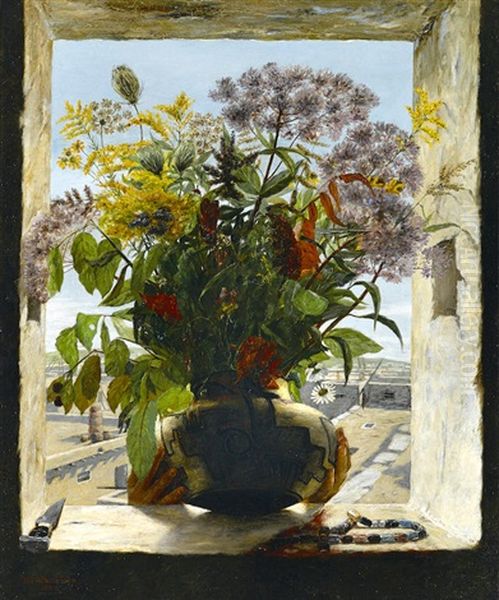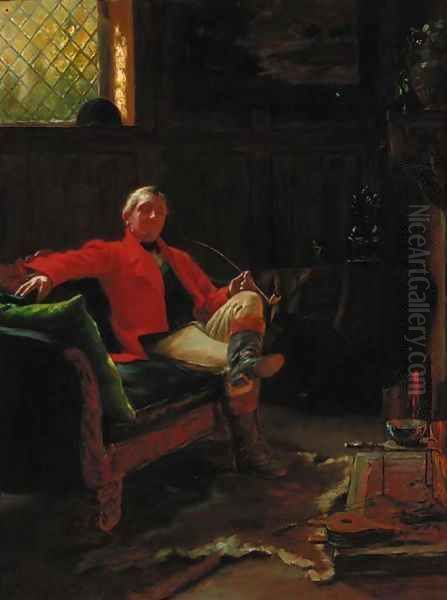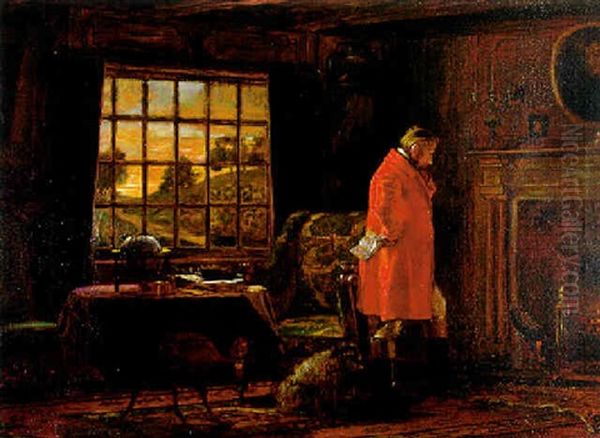William Verplanck Birney (1858-1909) stands as a noteworthy American painter whose career unfolded during the vibrant and transformative period of the late 19th and early 20th centuries, often referred to as the Gilded Age. While perhaps not as universally recognized today as some of his contemporaries who pioneered modernism, Birney was a skilled artist, well-trained in academic traditions, who produced a body of work that reflected the tastes and artistic currents of his time. His life and art offer a valuable window into the world of American genre painting, portraiture, and the transatlantic artistic exchanges that shaped the nation's cultural landscape.
Early Life and Formative Artistic Education
Born on July 5, 1858, William Verplanck Birney hailed from a family with deep roots in American history, being connected to the prominent Verplanck family of New York, whose lineage traced back to Dutch colonial times. This heritage placed him within a social stratum that often valued cultural pursuits, including the fine arts. His artistic inclinations led him to seek formal training, a common path for aspiring painters of his generation who understood the importance of mastering foundational skills.
Birney's initial artistic education took place in the United States. He spent a year, from 1876 to 1877, at the Massachusetts Normal Art School in Norwood. This institution, now known as the Massachusetts College of Art and Design, was one of the first of its kind in the country, established to provide training in drawing and design, often with an emphasis on preparing art educators. Following this, in 1878, Birney furthered his studies for a year at the prestigious Pennsylvania Academy of the Fine Arts (PAFA) in Philadelphia. PAFA was, and remains, one of America's leading art schools, boasting an illustrious faculty and alumni. During the period Birney attended, or shortly thereafter, figures like Thomas Eakins were profoundly influencing its curriculum with a strong emphasis on anatomical study and direct observation, pushing American art towards a more rigorous realism. While the provided information mentions "Professor Eakins" in relation to his Munich studies, it is more historically accurate to associate Eakins's direct teaching influence with PAFA.
The Munich Experience: A Crucible for American Artists

The allure of European art centers was irresistible for ambitious American artists in the late 19th century. Paris was the undisputed capital, but Munich, Germany, also emerged as a significant hub, particularly known for its Royal Academy of Fine Arts. Birney, like many of his compatriots, sought advanced training there, enrolling at the Royal Academy in Munich for a significant period, from 1884 to 1886. This was a crucial phase in his development.
In Munich, Birney studied under respected masters such as Gyula Benczúr, a Hungarian history painter known for his lavish and detailed canvases, and Wilhelm Lindenschmit the Younger, a German painter also recognized for his historical and genre scenes. The Munich School was characterized by its dark, rich palettes, bravura brushwork, and a strong emphasis on realism, often applied to portraiture, figure studies, and genre scenes. Artists like Frank Duveneck, William Merritt Chase, and John Henry Twachtman, all prominent American painters, also spent formative years in Munich, absorbing these stylistic traits before returning to the United States to adapt them to American subjects and sensibilities. Birney's immersion in this environment undoubtedly shaped his technical approach and artistic vision. His dedication was recognized early on when he received an "Honorable Mention" at the Munich International Exhibition in 1881, an accolade that would have bolstered his confidence and reputation.
An Artist in New York: Career and Affiliations
Upon completing his European studies, which also reportedly included time in Paris, William Verplanck Birney established himself as a professional artist, choosing New York City as his primary base of operations. New York was rapidly becoming the artistic and cultural epicenter of the United States, offering a vibrant community of artists, galleries, patrons, and exhibiting opportunities.
Birney became an active participant in the city's art scene. He was a member of the New York Water Color Club, an organization that played an important role in promoting watercolor as a serious medium. Membership in such clubs provided artists with platforms for exhibition, professional networking, and the exchange of ideas. His involvement suggests a proficiency and interest in watercolor, alongside his work in oils.

Throughout his career, Birney's works were featured in various exhibitions, a testament to his standing within the artistic community. He exhibited at the National Academy of Design, a venerable institution that held annual exhibitions crucial for an artist's visibility. A significant recognition came at the Pan-American Exposition held in Buffalo, New York, in 1901, where he was awarded a Bronze Medal. This exposition was a major international event, and receiving an award there would have been a notable achievement, placing his work before a wide audience and alongside that of other leading American and international artists of the day, such as Childe Hassam, Edmund C. Tarbell, and Frank W. Benson, who were also medalists at the same exposition.
Artistic Style, Thematic Concerns, and Notable Works
William Verplanck Birney's artistic output primarily consisted of genre scenes, interiors, and possibly portraits, executed in a style that blended academic realism with the rich tonalities and painterly qualities often associated with the Munich School. His work is generally characterized by careful draftsmanship, a keen observation of detail, and an ability to capture the nuances of light and atmosphere, particularly in interior settings.
One of the stylistic traits noted in some descriptions of his work is a tendency to depict figures from the back or illuminated from above and behind. This compositional device can create a sense of intimacy, mystery, or focus attention on the environment and the interplay of light, rather than solely on the figure's facial expression. This approach was not uncommon among Victorian-era painters who sought to create evocative moods and narrative suggestions.
Among his known or attributed works, several provide insight into his thematic interests:
_Between Sets_ (1886): This oil painting, measuring 32 x 26 inches, is a significant dated work from the period immediately following his Munich studies. The title suggests a scene from the theater or a musical performance, perhaps depicting performers or audience members during an intermission. Such subjects were popular, offering opportunities to portray social interactions, elegant attire, and atmospheric interiors. The reported auction estimate of $40,000 to $60,000 in 2001 indicates a recognized market value for his more substantial pieces.
_After the Hunt_ (theme): The provided information mentions a work by Birney titled After the Hunt, described as an interior scene with a nobleman smoking by a fireplace, presented in a gold frame. This theme was popular in 19th-century art. William Michael Harnett, a contemporary known for his trompe-l'œil still lifes, famously painted several versions of After the Hunt (e.g., his 1885 version), which typically depicted game, hunting gear, and related paraphernalia in meticulous detail. Birney's interpretation, focusing on a figure in an interior, would align more with genre painting, perhaps evoking a sense of leisure, contemplation, or the masculine pursuits of the era, similar in spirit to works by artists like Eastman Johnson or Thomas Hovenden who depicted domestic and social narratives.

_Pueblo Still Life_: The mention of this work suggests an interest in diverse subject matter, possibly reflecting the broader American fascination with Native American cultures and artifacts that grew in the late 19th century. Artists like E. Irving Couse and Joseph Henry Sharp were building careers around depictions of Native American life. A still life featuring Pueblo pottery would indicate Birney's engagement with these themes, perhaps through collected objects, and would showcase his skills in rendering textures and forms, akin to the still life traditions of artists like John F. Peto or Severin Roesen, though likely with a different cultural inflection.
_From Out of the Storm_: This painting was reportedly exhibited in 1910 at the "33rd Annual Painting Exhibition" and priced at ,000. The title evokes a dramatic narrative, possibly a marine scene or a figurative work with a strong emotional component, reminiscent of the narrative power seen in some works by Winslow Homer. The exhibition in 1910 would have been posthumous, suggesting the work was considered significant enough for inclusion.
His works were also exhibited at venues like the Albany Art Gallery in 1907, further indicating his active participation in the regional and national art circuit. The subjects he chose—cozy interiors, moments of quiet reflection, social vignettes—were characteristic of much Victorian genre painting, appealing to a public that appreciated narrative clarity, technical skill, and sentimental or anecdotal themes. Artists like John George Brown, known for his depictions of street urchins, or Seymour Joseph Guy, with his charming scenes of childhood, catered to similar sensibilities, though Birney's European training likely lent a different kind of sophistication to his handling.
Contextualizing Birney: The American Art World of His Time
To fully appreciate William Verplanck Birney, it's essential to place him within the dynamic art world of the late 19th century. This was an era of significant artistic ferment in America. The Hudson River School's dominance in landscape painting was waning, giving way to a variety of new influences and styles.
The impact of European study, particularly in Munich and Paris, was profound. Artists returning from abroad, like Birney, Chase, Duveneck, and Twachtman from Munich, or figures like John Singer Sargent and James Abbott McNeill Whistler who became expatriates, brought back new techniques and aesthetic philosophies. The Munich School's dark palette and vigorous brushwork offered an alternative to the tighter, more detailed style of earlier American painting or the brighter palettes of French Impressionism.
American Realism, championed by figures like Thomas Eakins and Winslow Homer, continued to be a powerful force, emphasizing direct observation and unvarnished depictions of American life. Birney's work, with its focus on genre scenes and interiors, can be seen as part of this broader realist impulse, albeit often with a more polished, Victorian sensibility.
Simultaneously, American Impressionism was gaining traction, with artists like Childe Hassam, J. Alden Weir, and Theodore Robinson adapting French Impressionist techniques to American landscapes and cityscapes. While Birney's style seems more aligned with academic realism and the Munich tradition, he would have been aware of these evolving trends. The art world was a place of diverse, sometimes competing, aesthetic approaches.
Institutions like the National Academy of Design, the Society of American Artists (formed by younger, European-trained artists seeking alternatives to the NAD), and various watercolor societies and art clubs provided crucial infrastructure for artists. The rise of art dealers and commercial galleries also began to play a more significant role in shaping artists' careers and public taste. Patrons and collectors, often newly wealthy industrialists, were eager to acquire art that reflected their status and cultural aspirations, frequently favoring European works or American art that demonstrated European academic polish.
Later Life, Marriage, and Legacy
On October 28, 1895, William Verplanck Birney married Emily Lucy Middleton. This personal milestone occurred during the height of his professional career. He continued to paint and exhibit, contributing to the artistic life of New York and beyond.
William Verplanck Birney passed away in 1909. His death marked the end of a career that spanned a period of significant change in American art. While he may not have been a radical innovator in the vein of the early modernists who were beginning to emerge around the time of his death, he was a highly competent and respected painter within the traditions he embraced. His work reflects the solid academic training he received and the prevailing tastes for well-crafted genre scenes and interiors that characterized much of Victorian-era art.
Historically, artists like Birney, who worked skillfully within established conventions, can sometimes be overshadowed by those who broke more dramatically with tradition. However, their contributions are vital for a complete understanding of the artistic landscape of their time. They represent the mainstream of artistic practice, satisfying a public demand for art that was both aesthetically pleasing and narratively engaging. His paintings offer glimpses into the domestic life, social customs, and aesthetic preferences of Gilded Age America.
Today, William Verplanck Birney's works can be found in private collections and occasionally appear at auction. His paintings serve as valuable documents of a particular strand of American art, one that valued technical proficiency, narrative content, and the depiction of everyday life with a refined, often sentimental, touch. He was part of a generation of American artists who benefited from rigorous European training and sought to apply those skills to subjects that resonated with an American audience, contributing to the rich tapestry of the nation's artistic heritage alongside contemporaries such as Thomas Wilmer Dewing, known for his ethereal figures, or the genre painter Enoch Wood Perry. His legacy is that of a dedicated artist who skillfully navigated the art world of his time, leaving behind a body of work that continues to hold interest for its craftsmanship and its reflection of a bygone era.